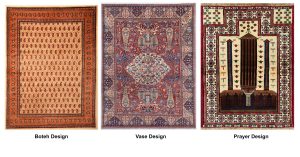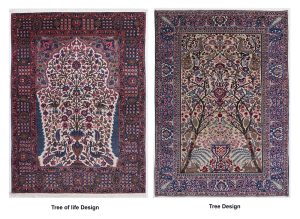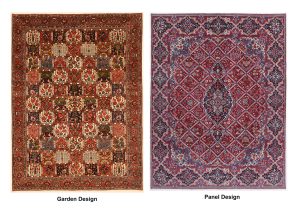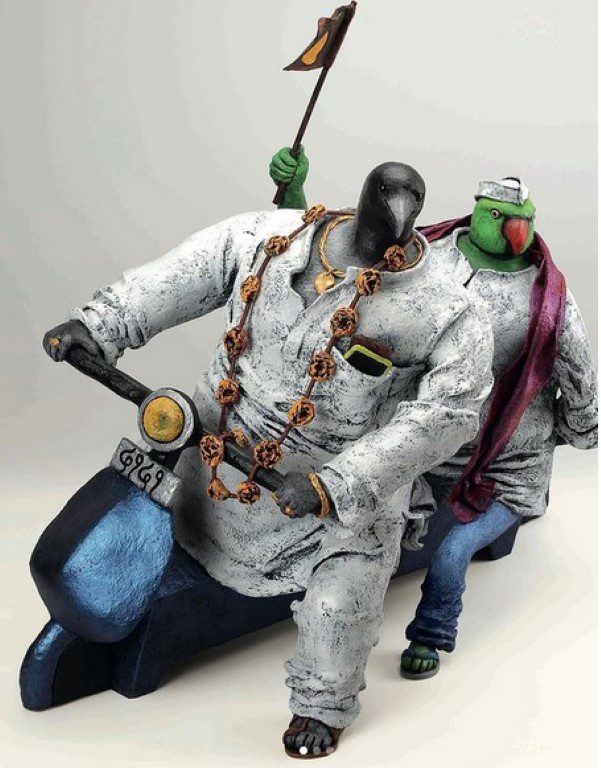Prachi Sahasrabudhe
Persian rugs are renowned around the world for their stunning beauty and expert craftsmanship. These carpets have a millennia-long history, having originated in ancient Persia (present-day Iran). Persia is renowned as the birthplace of carpet design, a kind of art for which the Persians have unique talents and knowledge. Their natural impulse is to formalise any subject or thought into a design or pattern that adheres to recognised norms. Persia has a significantly longer history of carpet design than the West, as carpets were not widely used in England until the nineteenth century. This article investigates the origins of Persian carpets, tracks their historical growth, and discusses their modern-day appeal.
“There lies a great mystery within the forms in Persian rugs.” (Samvat, 1998)
The art of Persian rug weaving dates to prehistory. Rug-making in Persia goes back to 2500 BCE, during the Bronze Age, according to archaeological findings. Nomadic tribes were instrumental in the early creation of Persian carpets, using them for utilitarian uses like warmth and shelter. Persian rugs have evolved dramatically in terms of design and workmanship throughout history. The carpets’ different reigning dynasties and cultural influences left permanent traces, resulting in a wide range of designs.
Early Persian rug manufacture began under the Achaemenid Empire (550-330 BCE). These carpets featured geometric designs and animal-inspired themes. Following Alexander the Great’s invasion of Persia, Greek influences were visible, combining legendary figures and floral motifs. The golden period of Persian rug weaving is the Safavid dynasty (1501-1736 CE). This time period witnessed the creation of beautiful floral and pictorial motifs. Cities like Isfahan and Kashan rose to prominence as rug production centres, producing carpets for palaces and noble households. The infusion of esoteric concepts into Persian rugs had its greatest impact during the Safavid dynasty in Iran and the Ottoman Empire in Turkey in the early sixteenth century. Sufi poets believed that ideas are things and that the quality of one’s thoughts influences colours. They combined shapes, colours, and many meanings to construct a three-dimensional notion that leads the spectator to the art’s underlying unity, which is nothing more than a mirror of the spirit in the world of matter. These artworks were a technique of communicating their message about their quest for Divine love. Political instability and international rivalry posed problems to Persian rugs during the nineteenth century. However, the Qajar dynasty (1794-1925 CE) revitalised the sector, resulting in the revival of Persian rug manufacturing. Qajar-era carpets had ornate medallion patterns and borders.
Rugs, runners, and kellegis had previously been manufactured by nomadic tribes and peasants, but there had been little advancement in workmanship. When rulers like Shah Rukh of Herat and Uzun Hassan of Tabriz commissioned court artists to sketch elaborate flower and animal motifs for huge carpets, it became essential to develop new technology for their manufacture. This method entailed sketching a preliminary sketch of the pattern and extending it to full size on squared paper, with each square representing a knot. Initially, each knot’s location was indicated by a pinhole, but these were quickly replaced with dots in ink or pencil.
Reza Samvat insists that while considering Persian rug design, three factors must be considered.
- The continuous design principle: This is true when the observer can notice the continuity of shapes and patterns while stepping outside of his comfort zone and limitations.
- The idea of numerous interpretations: Everyone’s interpretation of the carpets is based on their perspective of their own reality, both inner and exterior.
- The depth perception concept: Observing designs with more than five senses and adding sentiments and symbols.
The patterns on Persian carpets are testimony of the weavers’ talent, originality, and cultural legacy. These patterns not only improve the carpets’ visual appeal but also communicate historical, cultural, and symbolic meanings, making Persian rugs great works of art that endure over time. There are a few highlighting characteristics of Persian rugs that distinguish them from other handwoven carpets. These rugs are often woven to a pre-planned pattern, they have distinct qualities, with popular designs.
Rug Layouts: There are just a few different layouts for Persian carpets and rugs in general. Almost all of them share a few components, including a field, a border or numerous borders, and some type of medallion or pattern.
 Persian Rug Layout, https://www.little-persia.com/
Persian Rug Layout, https://www.little-persia.com/
Borders and Medallions: Persian rugs are distinguished by their ornate borders and medallions in the centre. The intricately woven borders of rugs frequently act as frames for the primary design. Medallions, which are found in the middle of the rug and act as the design’s main points, are frequently shaped geometrically or florally. The medallion is a common element in Anatolian and Persian carpets, frequently covering the entire central field. It can assume the shape of a multijointed star, an oval, or a nearly circular shape.
Rug Motifs: ‘Motifs’ are patterns found in Persian and Oriental rugs that have diverse meanings and are utilised based on the location the rug was woven in, however, it is not uncommon to see more than one motif in a single rug. The following are some of the most prevalent motifs:
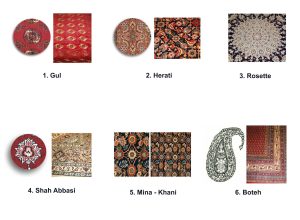 Persian Rug Motifs, https://www.little-persia.com/
Persian Rug Motifs, https://www.little-persia.com/
Colour Scheme: Persian rugs come in a variety of hues, from bright and flamboyant to subtle and subdued. Rich, deep colours like red, blue, and gold are frequently used in traditional Persian carpets, while earthy tones and natural dyes are sometimes used in tribal rugs. Natural dyes made from plants and insects give the colours more depth and richness, boosting the rug’s overall aesthetic appeal. Rugs manufactured in cities are woven by hand in workshops or factories from fibre coloured with chromium dyes. Village rugs are constructed of natural-coloured yarns and have rectilinear designs with basic verticals and horizontals. Each family has its own loom, which is a treasured heirloom.
Persian rugs are well known for their intricate and fascinating patterns, which highlight Iran’s rich cultural past. These patterns frequently incorporate themes, patterns, and hues that are not only visually appealing but also have cultural significance. Following are the highlighting components of Persian rug designs:
Geometric Patterns
Geometric designs are distinguished by angular forms surrounded by ridged lines. Persian carpets frequently have geometric patterns, such as elaborate medallions, geometric borders, and interlocking motifs. There are no constraints on the shape of the geometric patterns, which are most typically hexagonal, octagonal, diamond, or rhomboid. These intricately woven patterns give the rug’s design a feeling of harmony and balance. Individual weavers are free to integrate their own interpretations of geometric designs into their work. Based on the placement of geometric designs the geometric patterns are classified into: Geometric All-over, Geometric repeating medallion, Geometric Medallion Plain.
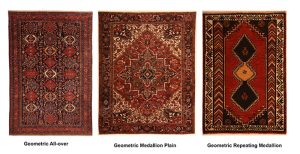 Geometric Pattern Rugs, https://www.catalinarug.com
Geometric Pattern Rugs, https://www.catalinarug.com
Reza Samvat observes geometrical patterns on the Persian rugs with a unique perception and elaborates, ‘The geometrical patterns are a representation of the levels of consciousness that humans gain as they travel towards God’s oneness. The rug’s form has mainly been comprised of squares or rectangles. A rectangle or square has four sides and four angles. The number four represents stability. Internal squares with four designed corners are also used. A centre design is frequently comprised of numerous geometrical forms such as a medallion, lampstand, or flowers with many petals.’
Floral Motif Patterns
In Persian culture, flowers and floral themes have significant symbolic meanings. Extensive floral patterns are a common motif on Persian rugs, with each blossom denoting a distinct significance. Lotus flowers stand for purity and rebirth, while roses symbolise beauty and love. The meticulous weaving of these floral patterns into the rug’s pattern gives it a touch of class and a feeling of natural beauty.
Different tribes and rug-making regions apply their own stylized flower motifs in diverse combinations, leading to the carpets’ plethora of floral designs. Some of the more typical floral arrangements in Persian carpets are Floral Medallion All-Over, Floral Medallion Plain Open Field, and Floral All-over.
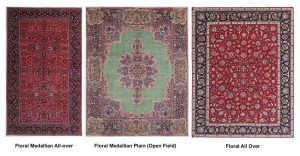 Floral Motif Pattern Rugs, https://www.catalinarug.com
Floral Motif Pattern Rugs, https://www.catalinarug.com
Herati Pattern
The Herati pattern is among the most well-known patterns seen on Persian rugs. This design has a core medallion in the shape of a diamond that is encircled by floral accents and curled leaves, generally running parallel to either side. Weavers can make basic geometric Herati patterns or complicated curvilinear designs. In most cases, the motifs cover the whole rug field. Water, fertility, and the cycle of life are all represented by the Herati pattern. It is frequently observed in carpets from the western Afghan city of Herat, which had a big impact on Persian rug making.
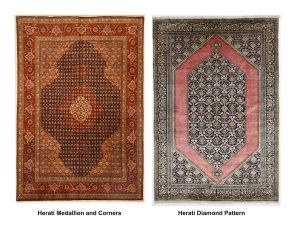 Herati Pattern Rugs, https://www.catalinarug.com
Herati Pattern Rugs, https://www.catalinarug.com
Pictorial Patterns
The major themes in pictorial patterns are animal and bird design representing a range of stylised animals and birds. These birds are frequently shown in complex woodland or garden settings surrounded by various flora and trees. Animal Carpets portray animals in strange shapes and postures, as well as whole hunting scenarios with hunters on foot and horseback and all the animals involved in the chase. Sheep, camels, horses, dogs, and camels are popular animals featured in these carpets, as are peacocks, eagles, and roosters. The mythological Phoenix and Dragon are frequently represented in Persian rugs from many areas. Some Persian carpets include pictorial patterns that represent scenes from daily life, historical occasions, or mythological tales. These narrative patterns frequently call for remarkable weaving prowess and meticulousness. Through their elaborate designs, pictorial carpets act as storytelling tools by evoking the stories and traditions of other cultures. Pictorial patterns include Boteh Design, Vase Design, and Prayer Design rugs as their subsidiaries.
Pictorial Patterns, https://www.catalinarug.com
Tribal and Nomadic Patterns
Nomadic tribes’ Persian carpets usually have unusual designs that honour their ethnic identity and rituals. These designs usually include bold geometric forms, tribal elements, and brilliant colour palettes. Nomadic rugs are highly valued because of their authenticity and links to Persia’s extensive nomadic history.
Universal Patterns
Motifs that are neither floral nor geometric are included in universal designs. These themes are frequently meaningful to the culture from where they emerged. They are highly stylized representations of real-life things, generally a variety of botanicals. At first look, it may be difficult to determine what the design represents in certain circumstances. Understanding what the design portrays and its importance requires a deeper understanding of the design and its roots. Tree designs & Garden and Panel Designs come under Universal Patterns.
Tree Design, https://www.catalinarug.com
Garden & Panel Design, https://www.catalinarug.com
Persian rugs continue to enchant people all over the world because of their timeless charm and remarkable quality. They are in high demand due to their distinctive patterns, precise craftsmanship, and longevity. Persian rugs are used in modern interior design to provide elegance, warmth, and a sense of luxury to diverse places. Their adaptability allows them to blend in with both classic and contemporary décor styles. Persian carpets’ mesmerising patterns and brilliant colours can convert any area into a visually appealing setting.
Collectors and aficionados view fine Persian rugs as priceless works of art and wise investments since they frequently increase in value over time, which contributes to the popularity of Persian rugs that goes beyond their visual appeal. The worlds of art and interior design place a high value on Persian rugs. These rugs have their roots in prehistoric Persia, but they have undergone centuries of evolution that represent the historical and cultural influences of many dynasties. Despite challenges throughout their long history, Persian rugs are still very sought-after today because of their ageless elegance, excellent craftsmanship, and economic value.
***
References:
- Ghazizadeh-Tehrani, P. (1979). Persian rugs: analysis of selected designs (Doctoral dissertation, Oklahoma State University), pp 34-77.
- Norouzianpour, H., December 2022, The Reflection of Persian Gardens in Persian Rug Design: A Comparative Study, Acta Via Serica, Keimyung University, Vol. 7, No. 2, pp 126,127, Doi: 10.22679/avs.2022.7.2.005
- Samvat, R. (1998). The Persian Carpet. Sydney Studies in Religion, pp 87 -92. • Persian Rugs and Design Patterns, https://www.catalinarug.com/blog/persian-rugs-design guide/
• Rug Layouts and Designs, https://www.little-persia.com/rug-guides/rug-design#layout



